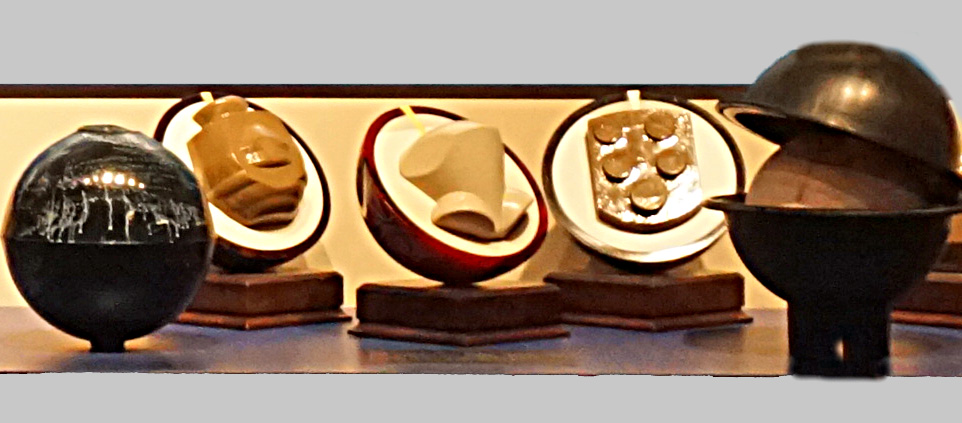|
Covina Bowl
The Covina Bowl is a former, googie-styled bowling alley located in Covina, California. The bowling alley operated from 1956 until closing in 2017. After closing, the bowling alley building and sign were preserved and integrated into a set of new townhomes. History Designed in 1955, then built in 1956 and designed by Powers, Daly, and DeRosa, the building's unique architecture was influenced by car culture, jets, the Atomic Age, and the Space Age. The familiar A-Frame neon sign arose that same year. The bowling alley, in addition to a space-age theme, also evoked an Egyptian theme in the interior that was added on in the 1970s. The alley originally had 32 lanes, and would later expand to 50. Due to years of decline, the Covina Bowl shut it doors on March 12, 2017, with the banquet rooms shutting down the year prior. After the closure, the property was considered highly endangered by the Los Angeles Conservatory, with the iconic property's future in the air. In 2021, the Covin ... [...More Info...] [...Related Items...] OR: [Wikipedia] [Google] [Baidu] |
Covina, California
Covina ( /koviːnə/) is a city in the San Gabriel Valley region of Los Angeles County, California, United States, about east of downtown Los Angeles The population was 51,268 according to the 2020 census, up from 47,796 at the 2010 census. The city's slogan, "One Mile Square and All There", was coined when the incorporated area of the city was only . Covina is bordered by West Covina, to its south and west side. Irwindale lies to the west, as well as the unincorporated area of Vincent, and the city of Baldwin Park. Azusa and Glendora are to the north, the unincorporated community of Charter Oak to the northeast, San Dimas to the east, the unincorporated area of Ramona and city of Pomona to the southeast. History Present-day Covina was originally within the homelands of the indigenous Tongva people for 5,000 to 8,000 years. In the 18th century it became part of Rancho La Puente in Alta California, a 1770s Spanish colonial and 1842 Mexican land grant. The city of ... [...More Info...] [...Related Items...] OR: [Wikipedia] [Google] [Baidu] |
Googie Architecture
Googie architecture ( ) is a type of futurist architecture influenced by car culture, Jet aircraft, jets, the Atomic Age and the Space Age. It originated in Southern California from the Streamline Moderne architecture of the 1930s, and was popular in the United States from roughly 1945 to the early 1970s. Googie-themed architecture was popular among roadside businesses, including motels, coffee houses and gas stations. The style later became widely known as part of the mid-century modern style, elements of which represent the populuxe aesthetic, as in Eero Saarinen's TWA Terminal. The term ''Googie'' comes from the now-defunct Googies Coffee Shop in Hollywood, Los Angeles, Hollywood designed by John Lautner. Similar architectural styles are also referred to as Populuxe or Doo Wop. Features of Googie include upswept roofs, curvilinear, Geometry, geometric shapes, and bold use of glass, steel and neon signs. Googie was also characterized by Space Age designs symbolic of motion, s ... [...More Info...] [...Related Items...] OR: [Wikipedia] [Google] [Baidu] |
Townhomes
A terrace, terraced house ( UK), or townhouse ( US) is a type of medium-density housing which first started in 16th century Europe with a row of joined houses sharing side walls. In the United States and Canada these are sometimes known as row houses or row homes. Terrace housing can be found worldwide, though it is quite common in Europe and Latin America, and many examples can be found in the United Kingdom, Belgium, United States, Canada, and Australia. The Place des Vosges in Paris (1605–1612) is one of the early examples of the type. Although in early larger forms it was and still is used for housing the wealthy, as cities and the demands for ever smaller close housing grew, it regularly became associated with the working class. Terraced housing has increasingly become associated with gentrification in certain inner-city areas, drawing the attention of city planning. Origins and nomenclature Though earlier Gothic examples, such as Vicars' Close, Wells, are known, t ... [...More Info...] [...Related Items...] OR: [Wikipedia] [Google] [Baidu] |
Atomic Age
The Atomic Age, also known as the Atomic Era, is the period of history following the detonation of the first nuclear weapon, The Gadget at the '' Trinity'' test in New Mexico on 16 July 1945 during World War II. Although nuclear chain reactions had been hypothesized in 1933 and the first artificial self-sustaining nuclear chain reaction ( Chicago Pile-1) had taken place in December 1942, the Trinity test and the ensuing bombings of Hiroshima and Nagasaki that ended World WarII represented the first large-scale use of nuclear technology and ushered in profound changes in sociopolitical thinking and the course of technological development. While atomic power was promoted for a time as the epitome of progress and modernity, entering into the nuclear power era also entailed frightful implications of nuclear warfare, the Cold War, mutual assured destruction, nuclear proliferation, the risk of nuclear disaster (potentially as extreme as anthropogenic global nuclear wint ... [...More Info...] [...Related Items...] OR: [Wikipedia] [Google] [Baidu] |
Space Age
The Space Age is a period encompassing the activities related to the space race, space exploration, space technology, and the cultural developments influenced by these events, beginning with the launch of Sputnik 1 on October 4, 1957, and continuing to the present. This period is characterized by changes in emphasis on particular areas of space exploration and applications. Initially, the United States and the Soviet Union invested unprecedented amounts of resources in breaking records and being first to meet milestones in crewed and uncrewed exploration. The United States established the National Aeronautics and Space Administration (NASA) and the USSR established the Kosmicheskaya programma SSSR to meet these goals. This period of competition gave way to cooperation between those nations and emphasis on scientific research and commercial applications of space-based technology. Eventually other nations became spacefaring. They formed organizations such as the European Spac ... [...More Info...] [...Related Items...] OR: [Wikipedia] [Google] [Baidu] |
Kona Lanes
Kona Lanes was a bowling center in Costa Mesa, California, that operated from 1958 to 2003. Known for its futuristic design, it featured 40 wood-floor bowling lanes, a amusement arcade, game room, a lounge, and a coffee shop that eventually became a Mexican cuisine, Mexican diner. Built during the advent of Googie architecture, its Polynesian culture, Polynesian-inspired Tiki culture, Tiki styling extended from the large neon sign, roadside sign to the building's neon lights and exaggerated rooflines. When Kona Lanes was demolished in 2003, it was one of the last remaining examples of the Googie style in the region; its sister center, Java Lanes in Long Beach, California, Long Beach, was razed in 2004. Much of Kona's equipment was sold prior to the demolition, but the distinctive sign was saved and sent to Cincinnati, where a portion is on permanent display in the American Sign Museum. Costa Mesa's planning commission approved a proposal to build a department store on the site, b ... [...More Info...] [...Related Items...] OR: [Wikipedia] [Google] [Baidu] |
Holiday Bowl (building)
The Holiday Bowl was a bowling alley on Crenshaw Boulevard in Los Angeles, California. It was founded in 1958 by five Japanese-Americans and was a significant part of the rebuilding process of the Nikkei community after internment during World War II. The owners of the Holiday Bowl sold shares throughout the community to finance its construction."Holiday bowl History project The Studio for Southern California History https://web.archive.org/web/20110930074200/http://www.socalstudio.org/collection/holiday_bowl/index.htm Cultural significance Located on Crenshaw Boulevard, the Holiday Bowl was important in the desegregation of Los Angeles and served an Anglo American, African American, and Japanese American clientele. The coffee shop served grits, udon, chow mein, and hamburgers. The Bowl operated four decades, and was a cultural, architectural, and recreational feature for the Crenshaw business district "as the Hollywood Bowl has for the Hollywood Hills".The Best...The Beautiful. ... [...More Info...] [...Related Items...] OR: [Wikipedia] [Google] [Baidu] |
Palos Verdes Bowl
The Palos Verdes Bowl was a bowling alley that stood on Crenshaw Boulevard and Amsler Street in Torrance, California. That operated from 1958 to January 31, 2020. It was one of the last examples of Googie architecture in the South Bay area of Los Angeles County, after Java Lanes was demolished in 2004. History Palos Verdes Bowl was built in 1958, opening as one of the first bowling alleys in the South Bay area, and the first in Torrance. The building would remain mostly unchanged throughout its 62-year run, except for a repaint of the familiar Googie style sign that stood over Crenshaw Boulevard in 2016. Due to financial difficulties, Palos Verdes Bowl, and a sale of the land for a retail center in 2019.{{cn The bowling alley closed it's doors on January 31, 2020.{{Cite web , date=2020-01-29 , title=Palos Verdes Bowl closes Friday after 61 years as a Torrance landmark , url=https://www.dailybreeze.com/2020/01/29/torrances-palos-verdes-bowl-closes-friday-after-more-than-six-d ... [...More Info...] [...Related Items...] OR: [Wikipedia] [Google] [Baidu] |
Bowling Alleys
Bowling is a target sport and recreational activity in which a player rolls a ball toward pins (in pin bowling) or another target (in target bowling). Most references to ''bowling'' are to pin bowling, specifically tenpin bowling, played in the United Kingdom and Commonwealth countries. ''Bowling'' can also refer to target bowling, such as lawn bowls. Bowling is played by 120 million people in more than 90 countries, including 70 million people in the United States alone. In pin bowling, players knock over pins on a long smooth surface called a ''lane''. Lanes have a wood or synthetic surface with protective lubricating oil applied in different oil patterns that affect ball motion. A strike is achieved when all the pins are knocked down on the first roll, and a spare is achieved if all remaining pins are knocked over on a second roll. The most common variation of pin bowling is tenpin; other variations include candlepin, duckpin, nine-pin (kegel), and five-pin. The histori ... [...More Info...] [...Related Items...] OR: [Wikipedia] [Google] [Baidu] |





